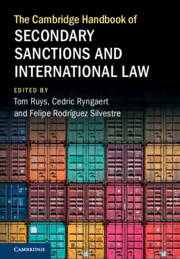Book contents
- The Cambridge Handbook of Secondary Sanctions and International Law
- The Cambridge Handbook of Secondary Sanctions and International Law
- Copyright page
- Contents
- Figures
- Contributors
- 1 Introduction
- Part I Secondary Sanctions
- 2 ‘Secondary Sanctions’
- 3 The Economic Effect of Secondary Sanctions on Firms
- 4 The Impact of Unilateral (Especially US Secondary) Sanctions
- 5 The EU and the Politics of US Secondary Sanctions
- Part II Secondary Sanctions and General Public International Law
- Part III Secondary Sanctions and International Economic Law
- Part IV Secondary Sanctions in Commercial Practices and Domestic Litigation
- Part V The Future of Secondary Sanctions
- Index
2 - ‘Secondary Sanctions’
What’s in a Name?
from Part I - Secondary Sanctions
Published online by Cambridge University Press: 14 December 2024
- The Cambridge Handbook of Secondary Sanctions and International Law
- The Cambridge Handbook of Secondary Sanctions and International Law
- Copyright page
- Contents
- Figures
- Contributors
- 1 Introduction
- Part I Secondary Sanctions
- 2 ‘Secondary Sanctions’
- 3 The Economic Effect of Secondary Sanctions on Firms
- 4 The Impact of Unilateral (Especially US Secondary) Sanctions
- 5 The EU and the Politics of US Secondary Sanctions
- Part II Secondary Sanctions and General Public International Law
- Part III Secondary Sanctions and International Economic Law
- Part IV Secondary Sanctions in Commercial Practices and Domestic Litigation
- Part V The Future of Secondary Sanctions
- Index
Summary
The aim of this conceptual chapter is to define international secondary sanctions and to address the contemporary legal challenges they raise. It proposes to explain such complex legal mechanisms, to overcome the apparent definitional wanderings in their regard, and to identify concrete keys to tackle the legal problems encountered by public and private practitioners. To this end, the analysis begins with an explanation of the core concepts underlying secondary sanctions and focuses on the aim of (extraterritorial) secondary sanctions to extend their scope, what the author calls ‘the reach dilemma’. The unilateral and extraterritorial mechanics of secondary sanctions are then illustrated by three original figures, allowing the reader to grasp the complexity of the different levers involved. The study then addresses the additional difficulty arising from the apparent plurality of definitions of secondary sanctions and proposes an explanatory key enabling to retain only one working definition of secondary sanctions stricto sensu. Finally, the chapter goes on with the identification of the main difficulties currently facing public and private legal practices in this field and presents legal solutions that offer avenues for resolution, in the short, medium and long term.
- Type
- Chapter
- Information
- Publisher: Cambridge University PressPrint publication year: 2024

